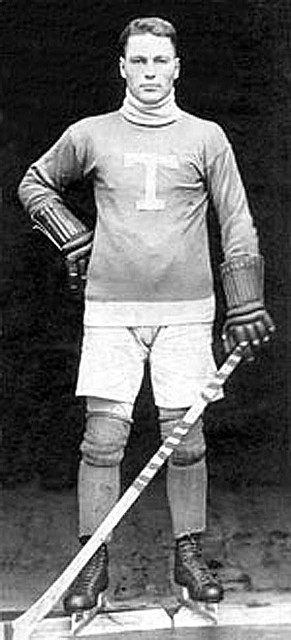close
News
Date published:
November 10, 2025
Allan McLean “Scotty” Davidson was born on March 6, 1891, in Kingston, Ontario. He grew up in Kingston and developed his hockey skills under the guidance of coach James T. Sutherland. At the age of 17, during the 1908–09 season, Davidson played in the Ontario Hockey Association (OHA) Senior division for the Kingston 14th Regiment team, leading the league with eight goals in four games. He subsequently joined the Kingston Frontenacs junior team, serving as captain and leading the team to consecutive championships in 1910 and 1911. Davidson was noted for his exceptional hockey sense, speed, and ability to anticipate plays, qualities that made him a standout even among the top junior players. In 1911–12, he moved west to Alberta to play senior-level hockey with the Calgary Athletics. He helped the team win the provincial championship, although they were unsuccessful in their challenge for the national Allan Cup.

Davidson turned professional in 1912 when he signed with the Toronto Blueshirts of the National Hockey Association (NHA). In his rookie season of 1912–13, he played 20 games, scoring 19 goals, and quickly transitioned from defence to right wing. The following season, he was appointed captain of the Blueshirts, a role that highlighted his leadership on and off the ice. During the 1913–14 season, Davidson recorded 23 goals and 13 assists in 20 games, ranking among the league’s top scorers. That year, the Blueshirts and the Montreal Canadiens finished the regular season tied in the standings, prompting a two-game total-goal series for the O’Brien Cup, which also determined control of the Stanley Cup. Toronto lost the first game 2–0 but won the second 6–0, with Davidson scoring two goals, including the decisive third goal. This victory marked the first time a Toronto-based team won the Stanley Cup. The Blueshirts went on to play a challenge series against the Victoria Aristocrats of the Pacific Coast Hockey Association, which Toronto won in three games, although the series was considered unofficial. Known for his speed, powerful shot, and ability to dominate play in both offensive and defensive situations, Davidson was regarded as one of the top all-around players in professional hockey at the time of his enlistment.

With the outbreak of the First World War in 1914, Davidson became the first professional hockey player to volunteer for the Canadian Expeditionary Force. He enlisted on September 22, 1914, initially with the 14th Regiment, but upon arrival in Europe he was reassigned to the Eastern Ontario Regiment and held the rank of Lance Corporal. During the voyage to England aboard the SS Cassandra, Lance Corporal Davidson participated in a shipboard boxing tournament, defeating David Carson of Kingston to become champion. His victory was reported in the Calgary Daily Herald on November 2, 1914, highlighting his athleticism beyond the hockey rink. While serving in France and Belgium, accounts describe Lance Corporal Davidson engaging in acts of bravery, including rescuing wounded officers and fighting in the front lines. He was killed in action on June 16, 1915, by a shell that exploded near him in the trenches. Davidson was 24 years old at the time of his death. His name is commemorated on the Canadian National Vimy Memorial in France.


Davidson’s legacy has been preserved through numerous posthumous honours. He was inducted into the Hockey Hall of Fame in 1950. In 1925, Maclean’s magazine named Davidson the top right-wing when compiling an all-star team of the greatest players to that point. Locally, he was remembered not only for his skill but also for his leadership and sportsmanship, qualities that earned him admiration both on the ice and in the community. Beyond his achievements in sport, Lance Corporal Davidson represents the generation of Canadian hockey players who served in the First World War, many of whom did not return. His life exemplifies the intersection of early professional hockey and military service, marking him as both an accomplished athlete and a soldier who made the ultimate sacrifice.
Discover similar stories behind the 11,285 names engraved on the Canadian National Vimy Memorial with Living Stories, our interactive app. Scan a name at the monument or search online to explore the personal histories of those who served and sacrificed.
Download the app: vimyfoundation.ca/livingmemorialvivant
Check out our products in our boutique
View All Products


$ 39.99
$ 39.99
.png)
$ 60.00
$ 60.00